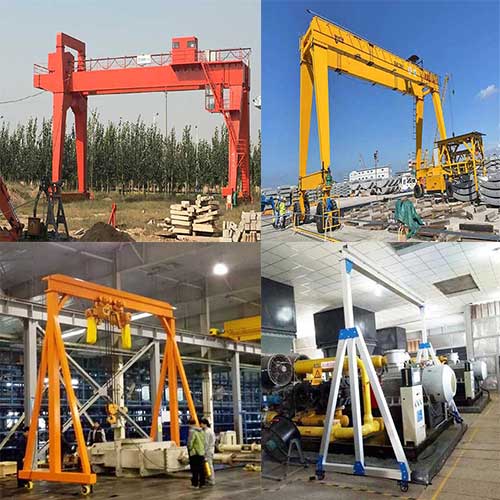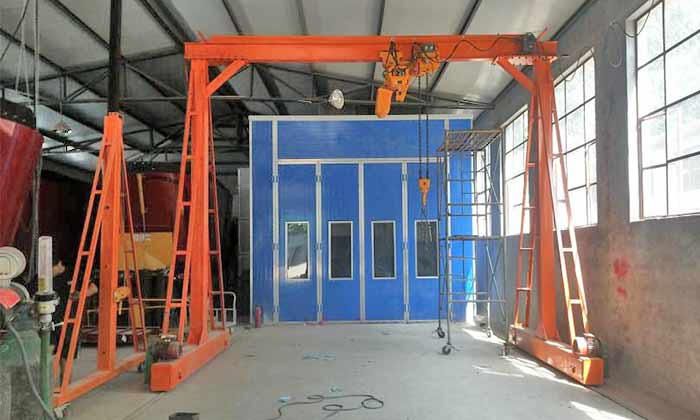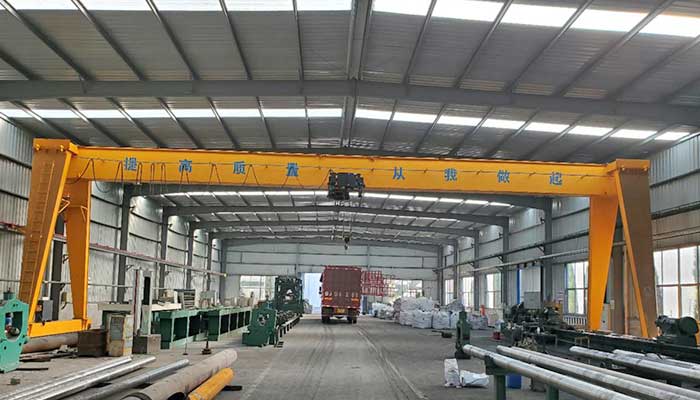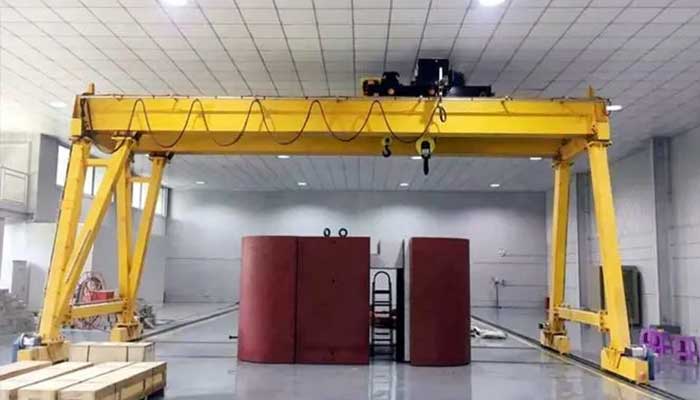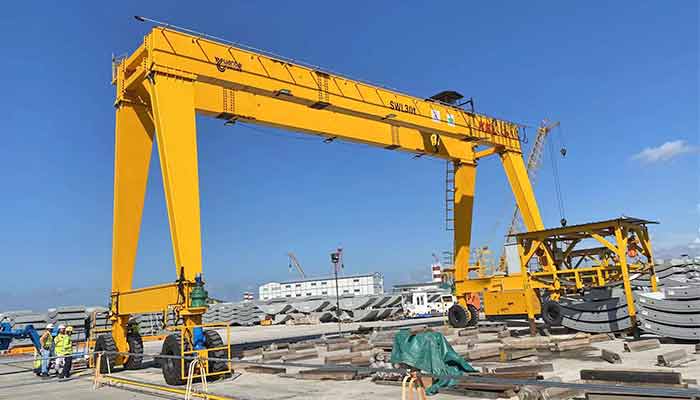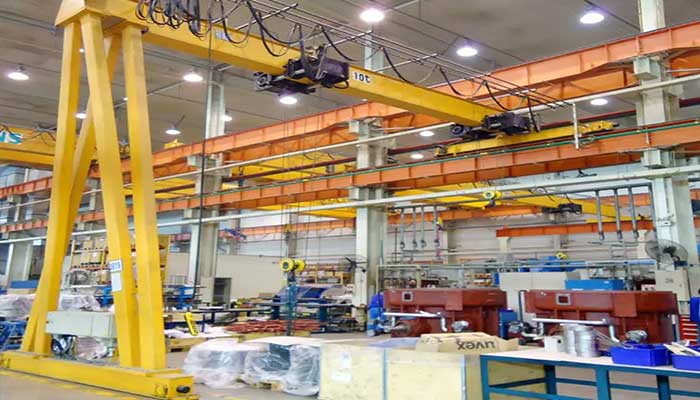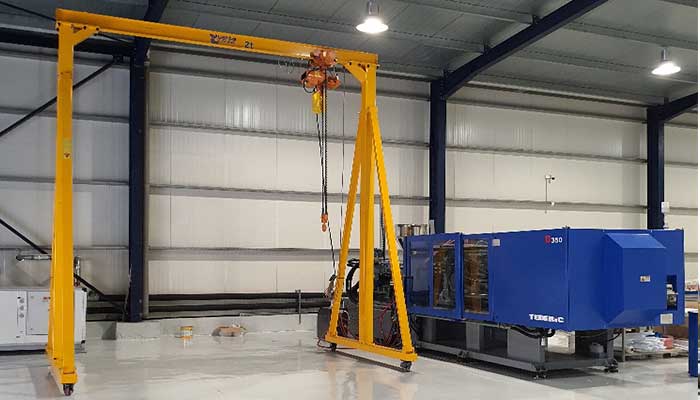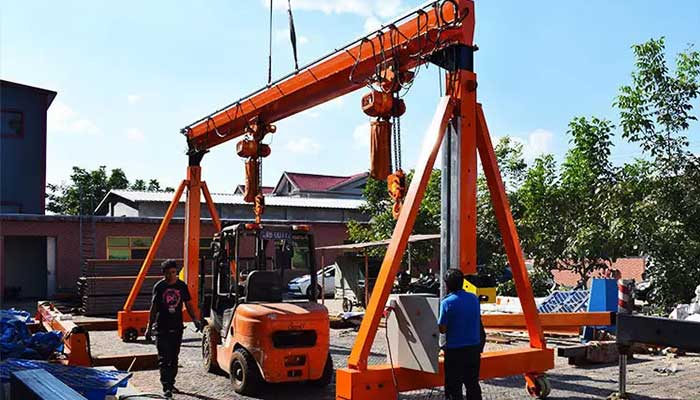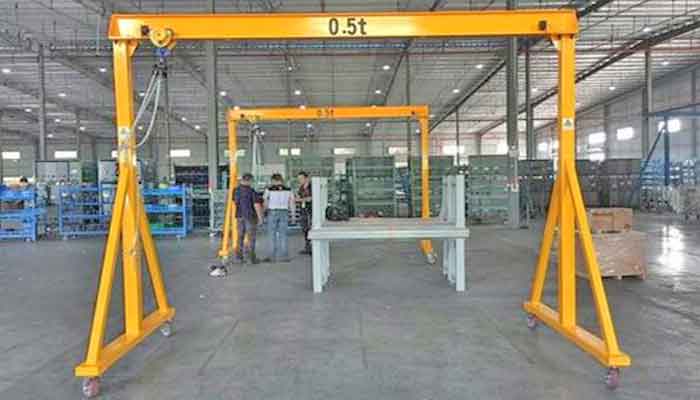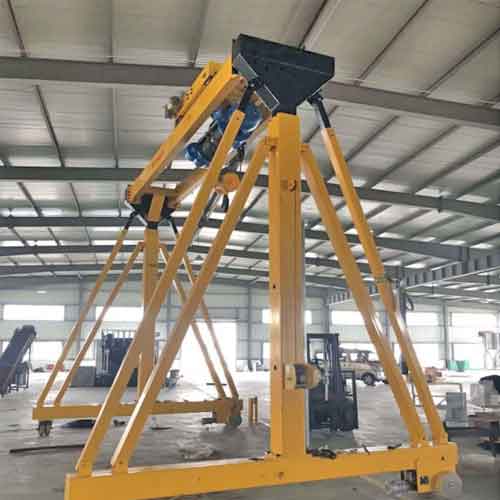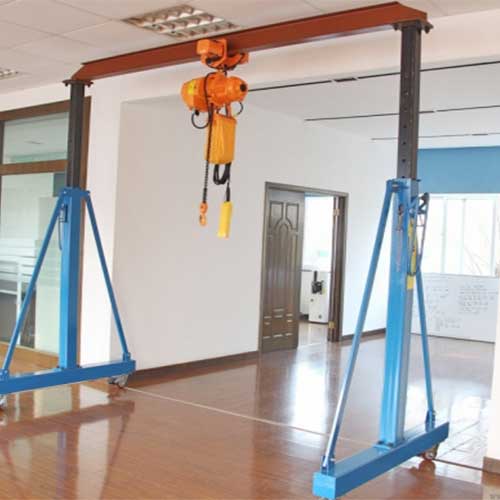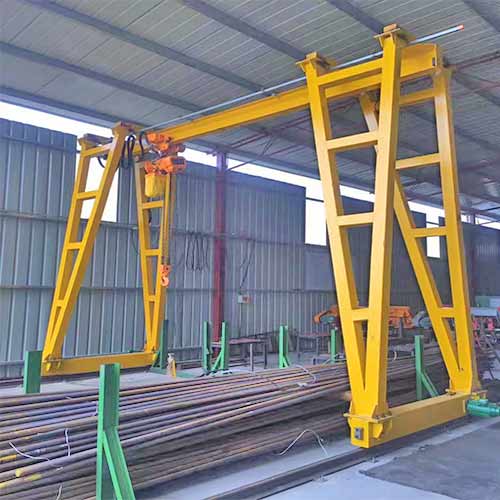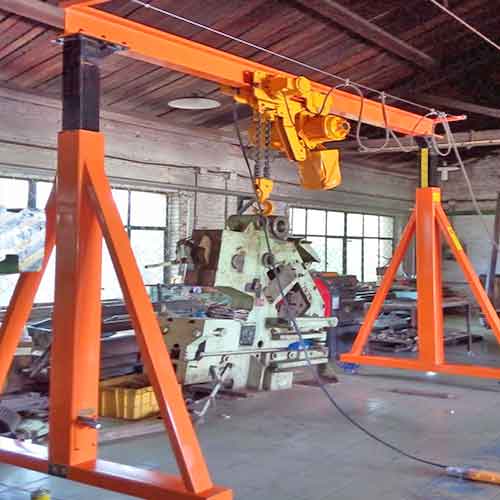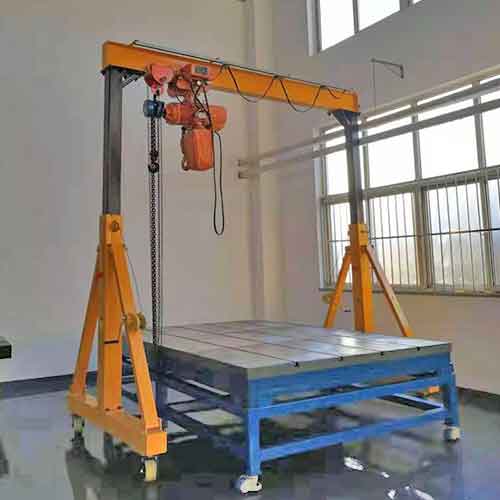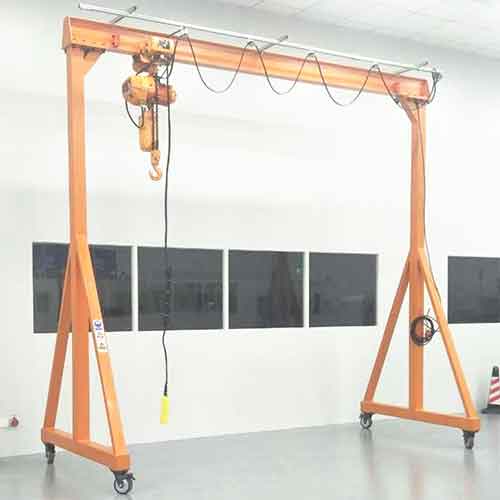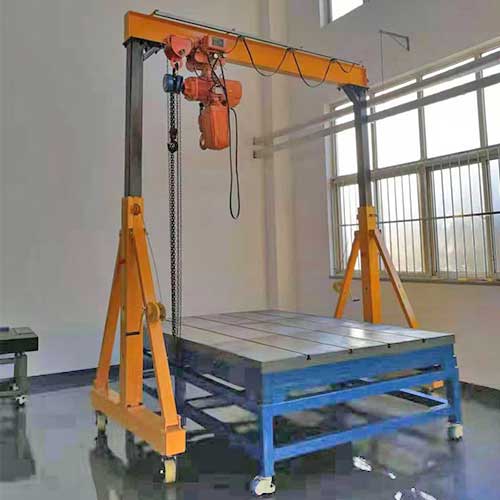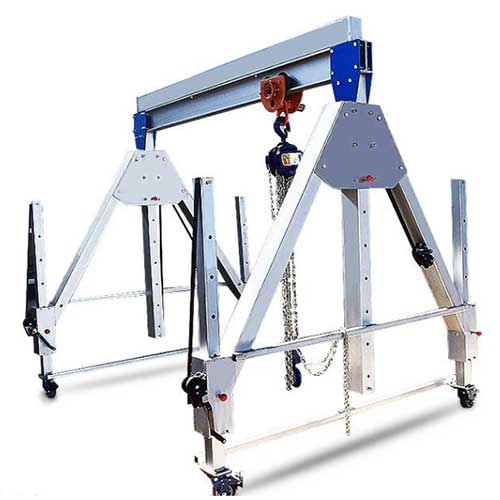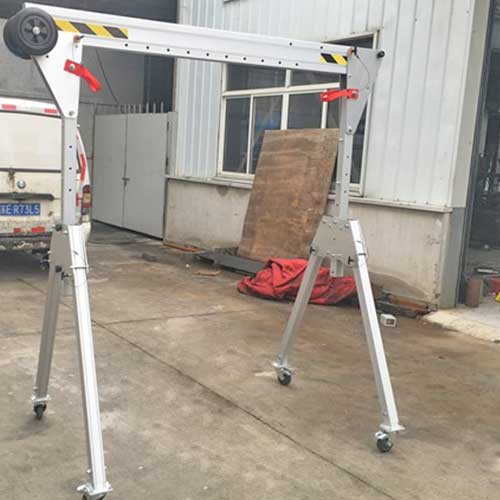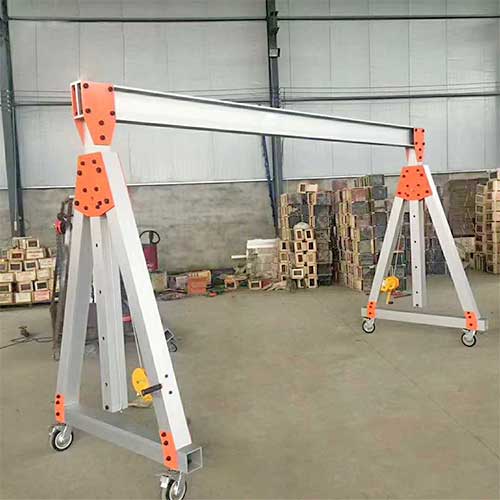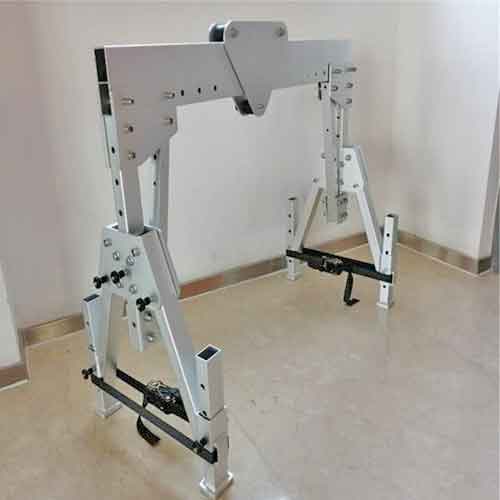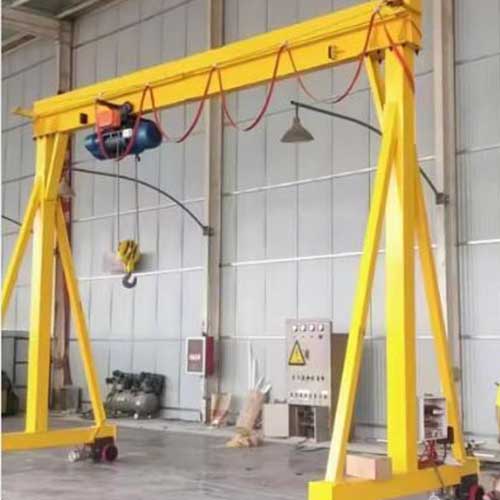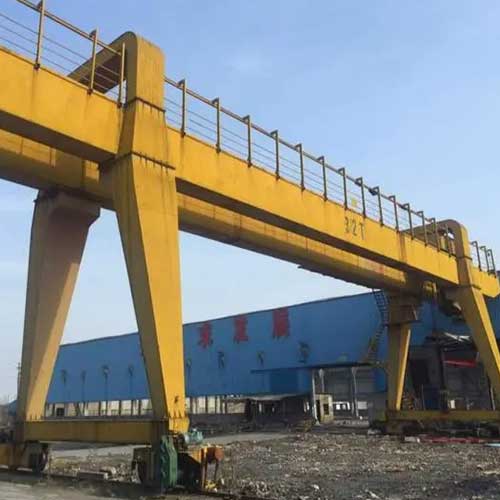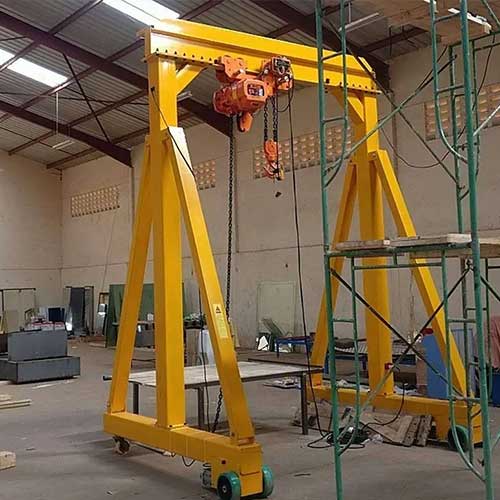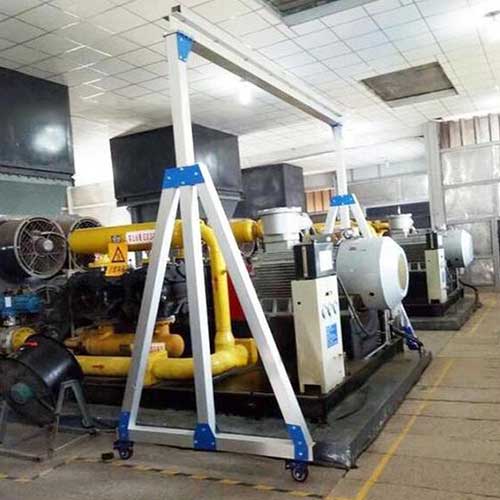A Frame Lifting Gantry: Heavy & Light Duty Lifting Gantry A Frame Crane
A Frame Lifting Gantry Cranes for Sale 0.25 Ton to 10 Ton. Custom design a frame lifting gantry, i.e, Heavy Duty & Light Duty Lifting Gantry A Frame Crane.
Category: A Frame Crane
Your Trusted A Frame Lifting Crane Manufacturer & Supplier
A Frame Lifting Gantry: Heavy & Light Duty Lifting Gantry A Frame Crane
A Frame Lifting Gantry Cranes for Sale 0.25 Ton to 10 Ton A Comprehensive Guide
A Frame Lifting Gantry Cranes for Sale 0.25 Ton to 10 Ton. Custom design a frame lifting gantry, i.e, Heavy Duty & Light Duty Lifting Gantry A Frame Crane.
A frame lifting gantry is a specialized lifting equipment designed to hoist and transport heavy loads within various industrial settings. It is characterized by its A-frame configuration, which provides stability and support for the lifting mechanism. This type of gantry is widely used for its versatility in handling diverse loads across industries.
The importance of a frame lifting gantry lies in its ability to streamline lifting processes, enhancing efficiency and safety in various sectors. Industries such as construction, manufacturing, shipbuilding, and aerospace heavily rely on these gantries for lifting and moving heavy frames, machinery, and components. The versatility of frame lifting gantries makes them indispensable in scenarios where traditional lifting methods fall short.
Before investing in a frame lifting gantry, buyers and users must carefully consider several key factors. The load capacity of the gantry must align with the specific lifting requirements of the application. The span width and height should accommodate the dimensions of the objects being lifte Mobility and portability are crucial considerations for dynamic work environments, while safety features and compliance with industry standards are paramount to ensure a secure working environment.
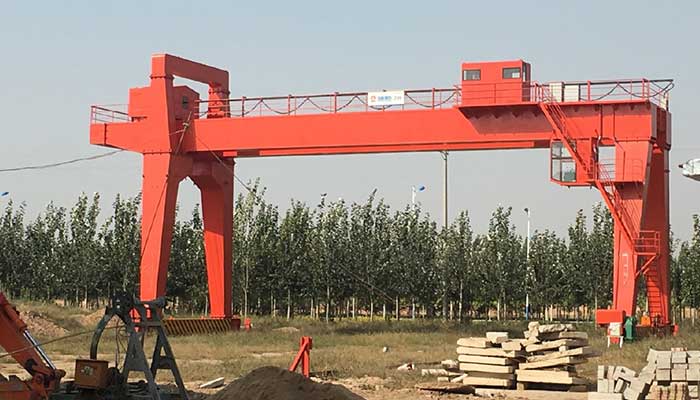
Heavy duty A Frame lifting gantry cranes
Anatomy of a Frame Lifting Gantry
Structural Components
- A-Frame Configuration The A-frame design is a distinctive feature of frame lifting gantries, providing exceptional stability during lifting operations. The A-frame consists of two vertical legs connected at the top by a horizontal beam, resembling the letter '' This configuration ensures a strong foundation, enabling the gantry to support heavy loads without compromising safety.
- Gantry Structure The gantry structure encompasses the entire framework that supports the lifting mechanism. Typically made from robust materials such as steel alloys, the structure is engineered to withstand the stresses of lifting heavy loads. The structural components are designed with precision, considering factors like load distribution, balance, and durability.
- Lifting Mechanism The lifting mechanism is the heart of a frame lifting gantry, responsible for elevating and lowering the loads. Common lifting mechanisms include electric hoists, hydraulic cylinders, or manual winches. The choice of mechanism depends on the application's specific requirements, with electric hoists being popular for their efficiency and ease of operation in many industrial settings.
Materials Used
- Steel Alloys Steel alloys are a preferred material for frame lifting gantries due to their exceptional strength and durability. The use of high-quality steel ensures that the gantry can handle heavy loads consistently. Additionally, steel offers resistance to wear, corrosion, and deformation, contributing to the gantry's long service life.
- Aluminum Aluminum is chosen for frame lifting gantries when weight is a critical consideration. Aluminum gantries are lighter than their steel counterparts, making them more portable and easier to maneuver. While not as robust as steel, aluminum still provides sufficient strength for many lifting applications and offers corrosion resistance.
- Composite Materials Innovations in material science have led to the exploration of composite materials in gantry construction. These materials, often a combination of fibers and resins, offer a unique balance of strength and lightness. Composite gantries are advantageous in applications where weight restrictions are crucial, and corrosion resistance is essential.
The intricacies of the structural components and materials used in a frame lifting gantry is fundamental for selecting the right equipment for specific applications. In the following sections, we will explore different types of frame lifting gantries, their key features, and how to make informed decisions based on specific lifting needs.
Heavy Duty A-Frame Lifting Gantries:
Heavy-duty A-frame lifting gantries represent robust and powerful solutions for the efficient handling of substantial loads in industrial, construction, and manufacturing settings. These gantry cranes are meticulously engineered to tackle the demands of lifting and moving large and heavy materials with precision and safety. The distinctive A-shaped structure of these gantries provides exceptional stability and support during operations.
Key Features:
- High Load Capacity: Heavy-duty A-frame lifting gantries are characterized by their impressive load-bearing capacity, making them indispensable for applications involving heavy machinery, oversized components, or bulk materials.
- Industrial Applications: These gantries find their primary use in heavy industrial environments where the need for lifting and relocating massive loads is prevalent. Sectors such as manufacturing, construction, and shipbuilding benefit significantly from the capabilities of these gantry cranes.
- Durable Construction: The construction of heavy-duty A-frame gantries involves the use of sturdy materials and robust components, ensuring durability and longevity under the rigors of frequent and intense usage.
- Advanced Safety Features: To meet the stringent safety requirements of handling heavy loads, these gantries often come equipped with advanced safety features and control systems. These features enhance operator confidence and contribute to accident prevention.
- Versatility in Applications: Heavy-duty A-frame lifting gantries exhibit versatility in adapting to diverse applications, whether it involves lifting machinery onto a production line or relocating massive components within a manufacturing facility.
- Precision and Control: With advanced control mechanisms, operators can achieve precise movements, allowing for accurate positioning of heavy loads. This precision is crucial in scenarios where delicate handling is required.
- Cost-Effective Efficiency: Despite their higher initial cost, heavy-duty A-frame gantries prove cost-effective in environments with consistently demanding lifting requirements. The efficiency gains and reduced manual labor offset the initial investment over time.
In conclusion, heavy-duty A-frame lifting gantries stand as stalwart solutions for industries demanding powerful, reliable, and safe material handling capabilities. Their robust design and high load capacity make them indispensable assets in environments where the scale and weight of materials necessitate specialized lifting equipment.
Single Girder A-Frame Lifting Gantry Crane vs. Double Girder A-Frame Lifting Gantry Crane
Single Girder A-Frame Lifting Gantries:
Single girder A-frame lifting gantries are efficient and versatile solutions designed for material handling applications where moderate lifting capacities are required. Characterized by a simple and lightweight structure, these gantries feature a single horizontal beam, or girder, that supports the hoist and trolley. This design makes them particularly suitable for environments with space constraints or lower lifting demands. Single girder A-frame gantries are cost-effective, providing a practical solution for industries such as workshops, warehouses, and smaller manufacturing facilities. Their adaptability and ease of installation make them valuable assets for lifting and moving loads with precision in a variety of settings.
Double Girder A-Frame Lifting Gantries:
Double girder A-frame lifting gantries are robust and powerful solutions tailored for heavy-duty lifting applications. Distinguished by their dual horizontal beams (girders), these gantries offer increased stability and higher load capacity compared to their single girder counterparts. The design allows for precise control and handling of large and heavy materials, making them ideal for industries requiring substantial lifting capabilities, such as manufacturing, construction, and shipbuilding. While double girder A-frame gantries may have a higher initial cost due to their more complex structure, they provide cost-effectiveness in scenarios where heavy loads and precision lifting are essential. The double girder design ensures enhanced stability, making them indispensable for applications demanding a high level of performance and control.
Single Girder A-Frame Lifting Gantry Crane:
- Design and Structure:
Single Girder: Features a single horizontal beam for supporting the hoist and trolley, creating a simpler and lighter structure compared to double girder gantry cranes. - Load Capacity:
Single Girder: Generally suited for lighter to moderate lifting applications. Ideal for environments where heavy loads are not a primary requirement. - Cost-Effectiveness:
Single Girder: Typically more cost-effective than double girder gantry cranes due to the simplicity of the design and lower material requirements. - Headroom and Height:
Single Girder: Offers a lower headroom, making it suitable for facilities with height restrictions. This can be advantageous when working in confined spaces. - Versatility:
Single Girder: Provides greater versatility in terms of installation, especially in spaces where the structure may need to be adapted to existing conditions.
Double Girder A-Frame Lifting Gantry Crane:
- Design and Structure:
Double Girder: Features two horizontal beams (girders) for supporting the hoist and trolley, creating a more robust and stable structure compared to single girder gantry cranes. - Load Capacity:
Double Girder: Designed for heavy lifting applications. Offers higher load capacity and is suitable for industries that require handling large and heavy materials. - Cost:
Double Girder: Generally comes with a higher initial cost due to the additional materials and complexity in design. However, it may provide cost-effectiveness for heavy-duty applications. - Headroom and Height:
Double Girder: Requires more headroom compared to single girder gantry cranes. This can be a consideration in facilities with height restrictions. - Stability and Precision:
Double Girder: Provides increased stability and precision during lifting operations, making it suitable for applications that demand precise control over heavy loads.
Comparison:
- Load Capacity: Double girder gantry cranes are designed for heavier lifting applications, while single girder gantry cranes are more suitable for lighter to moderate loads.
- Cost: Single girder gantry cranes are generally more cost-effective, making them a practical choice for applications with lower budget constraints. Double girder gantry cranes may have a higher initial cost but offer advantages in heavy-duty operations.
- Structure and Headroom: Single girder gantry cranes have a simpler structure and lower headroom, making them advantageous in confined spaces. Double girder gantry cranes provide enhanced stability and precision but may require more headroom.
- Versatility: Single girder gantry cranes offer greater versatility in installation and adaptation to existing structures. Double girder gantry cranes are more specialized for heavy-duty lifting applications.
In summary, the choice between a single girder and double girder A-frame lifting gantry crane depends on the specific lifting requirements, budget constraints, and spatial considerations of the application. Single girder cranes are suitable for lighter loads and versatile installations, while double girder cranes excel in heavy-duty applications demanding stability and higher load capacity.
Mobile A-Frame Lifting Gantries vs. Fixed A-Frame Lifting Gantries:
Mobile A-Frame Lifting Gantries:
Mobile A-frame lifting gantries are versatile and flexible solutions designed for dynamic work environments where the need for portability is crucial. These gantries feature wheels or casters that facilitate easy movement, allowing them to be transported to various locations within a facility or job site. This mobility enhances adaptability, making them suitable for applications where materials need to be lifted and moved across different workstations. Mobile A-frame gantries are particularly valuable in settings where the lifting requirements change frequently, providing a convenient and efficient solution for material handling on the go.
Key Features:
- Portability: The main feature of mobile A-frame gantries is their portability, enabling them to be moved easily to different locations within a workspace.
- Adaptability: Ideal for environments with changing operational needs, these gantries can be quickly repositioned to accommodate varying lifting requirements.
- Quick Deployment: The wheels or casters facilitate swift deployment, making them suitable for tasks that demand rapid response and movement.
- Spatial Efficiency: Mobile gantries contribute to spatial efficiency by eliminating the need for permanent installations. They are suitable for facilities where floor space is at a premium.
- Wide Range of Applications: Commonly used in industries such as maintenance, workshops, and construction, where materials need to be lifted and transported to different locations.
Fixed A-Frame Lifting Gantries:
Fixed A-frame lifting gantries, in contrast, are stationary structures permanently installed in a specific location within a facility. These gantries provide a stable and robust lifting solution, often chosen for applications with consistent and dedicated lifting requirements. Fixed gantries are well-suited for scenarios where the workstations are static, and there is no need for frequent repositioning. They offer a reliable and efficient lifting solution for industries that demand stability and precision in material handling operations.
Key Features:
- Stability: Fixed gantries provide a stable platform for lifting operations, minimizing vibrations and ensuring precise control over loads.
- High Load Capacity: Due to their fixed nature, these gantries can be designed for higher load capacities, making them suitable for heavy-duty applications.
- Permanent Installation: Fixed gantries are installed in a fixed location, providing a consistent and dedicated solution for lifting tasks in a specific area.
- Safety: The stationary nature of fixed gantries contributes to enhanced safety during lifting operations, particularly in applications where stability is critical.
- Precision Handling: Well-suited for applications demanding precise control over heavy loads, such as manufacturing processes or assembly lines.
Mobile vs. Fixed A Frame Lifting Gantries
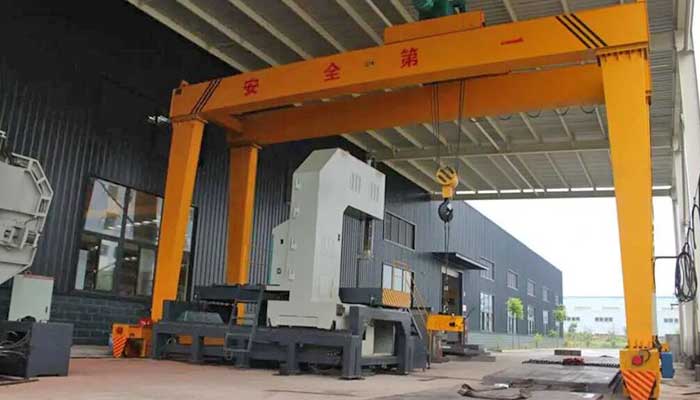
Rail mounted a frame lifting gantries
Comparison:
- Mobility: Mobile gantries are portable and adaptable to changing work environments, while fixed gantries provide a stable and dedicated lifting solution in a specific location.
- Applications: Mobile gantries are ideal for dynamic work environments with varying lifting requirements, while fixed gantries excel in providing stability and precision for consistent lifting tasks.
- Load Capacity: Fixed gantries can be designed for higher load capacities, making them suitable for heavy-duty applications, whereas mobile gantries are generally more lightweight and designed for moderate loads.
In summary, the choice between mobile and fixed A-frame lifting gantries depends on the specific operational needs, spatial considerations, and the level of adaptability required in a given application. Mobile gantries offer flexibility, while fixed gantries provide stability and strength for dedicated lifting tasks.
Single Leg A-Frame Lifting Gantry Cranes vs. Double Leg A-Frame Lifting Gantry Cranes:
Single Leg A-Frame Lifting Gantry Cranes:
Single leg A-frame lifting gantry cranes, also known as monorail gantry cranes, are characterized by a single vertical support structure that connects to an inclined beam forming an "A" shape. These cranes provide a compact and versatile solution for material handling in environments where a dedicated track or runway is not feasible. Single leg gantries are suitable for applications where the lifting requirements are moderate, and they are often used in maintenance areas, workshops, or locations with limited space.
Key Features:
- Compact Design: Single leg gantries have a compact and space-efficient design, making them suitable for locations where a traditional double leg gantry might be impractical.
- Portability: Due to their lighter weight and simpler structure, single leg gantries are more portable and easier to relocate within a workspace.
- Moderate Load Capacity: These gantries are designed for moderate load capacities, making them appropriate for applications with lighter lifting requirements.
- Adaptability: Single leg gantries are adaptable to various work environments, offering a solution in scenarios where a fixed track or runway is not viable.
Double Leg A-Frame Lifting Gantry Cranes:
Double leg A-frame lifting gantry cranes are characterized by two vertical support structures, creating a more stable and robust lifting solution. The double leg design allows for higher load capacities and increased stability, making them suitable for heavy-duty lifting applications. These gantries are commonly used in industrial settings, construction sites, and manufacturing facilities where substantial loads need to be lifted and maneuvered with precision.
Key Features:
- Stability and Strength: The dual vertical support legs provide increased stability, allowing double leg gantries to handle heavier loads compared to their single leg counterparts.
- Higher Load Capacity: Designed for heavy-duty applications, double leg gantries offer a higher load capacity, making them suitable for industries that require lifting and moving large and heavy materials.
- Precision Handling: The enhanced stability of double leg gantries allows for more precise control over lifting operations, ensuring accurate positioning of heavy loads.
- Fixed or Permanent Installation: Double leg gantries are often installed in a fixed location, providing a dedicated lifting solution in specific areas where consistent and robust performance is required.
Comparison:
- Load Capacity: Double leg gantries are designed for higher load capacities, while single leg gantries are suitable for applications with moderate lifting requirements.
- Stability: Double leg gantries offer increased stability due to their dual support structure, making them ideal for heavy-duty lifting operations.
- Portability: Single leg gantries are more portable and adaptable to different locations, whereas double leg gantries are typically installed in a fixed location for dedicated heavy lifting tasks.
- Applications: Single leg gantries are suitable for smaller workshops and maintenance areas, while double leg gantries excel in industrial settings with heavy-duty lifting demands.
In summary, the choice between single leg and double leg A-frame lifting gantry cranes depends on the specific lifting requirements, space constraints, and the level of stability and load capacity needed in a given application. Single leg gantries offer versatility and adaptability, while double leg gantries provide robust solutions for heavy-duty lifting tasks.
Single vs. Double Leg Gantries
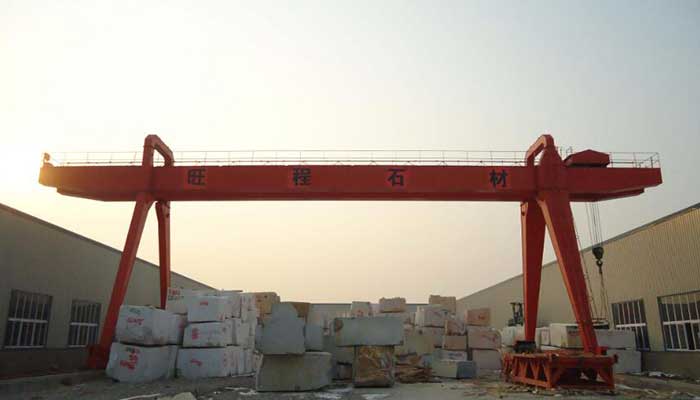
Double leg a frame lifting gantries
- Single Leg Gantries Single leg gantries have one vertical support structure, typically resembling a 'T' shape. These gantries are suitable for applications with lighter loads or when space is limite They provide a clear path for load movement and are often more maneuverable in confined spaces.
- Double Leg Gantries Double leg gantries feature two vertical supports in an A-frame configuration, offering enhanced stability and load-bearing capacity. These gantries are well-suited for heavier lifting tasks and applications where a higher degree of stability is require Double leg gantries are a popular choice in industries such as construction and manufacturing.
Portable Light Duty A-Frame Gantry Crane:
Portable light duty A-frame gantry cranes offer a versatile and mobile solution for lifting and moving moderate loads in a variety of settings, such as workshops, warehouses, and smaller manufacturing facilities. These cranes are designed to provide flexibility and convenience, allowing users to efficiently handle materials within confined spaces while maintaining ease of transportation.
Key Features:
- Moderate Load Capacity: Portable light duty A-frame gantry cranes are specifically engineered for applications where the lifting requirements are less substantial. They are well-suited for handling smaller machinery, components, and materials.
- Workshop and Small-scale Applications: These gantry cranes find their primary use in workshops, maintenance areas, and smaller production facilities where the lifting needs are frequent but not as heavy or complex.
- Compact and Portable Design: The hallmark of these gantry cranes is their compact and portable design. They can be easily moved to different locations within a workspace, allowing for adaptability in responding to changing operational demands.
- Cost-Effective Solution: Offering a cost-effective solution for lighter lifting requirements, portable light duty A-frame gantry cranes provide an economical alternative without compromising on functionality. Their affordability makes them accessible for small to medium-sized businesses.
- Quick Assembly and Disassembly: Designed with user convenience in mind, these gantry cranes often feature a straightforward assembly and disassembly process. This allows for quick setup and breakdown, facilitating efficient use in various locations.
- Easy Maneuverability: Equipped with wheels or casters, these gantry cranes can be easily maneuvered around obstacles or tight spaces. The mobility ensures that materials can be lifted and transported precisely where needed within the workspace.
- Adaptable to Various Environments: Portable light duty A-frame gantry cranes prove adaptable to different environments due to their smaller footprint. They are particularly suitable for facilities with spatial constraints, offering an effective lifting solution without the need for a permanent installation.
In summary, portable light duty A-frame gantry cranes provide a practical and cost-effective solution for organizations with moderate lifting requirements. Their mobility, compact design, and ease of use make them valuable assets in environments where space is a consideration, and the lifting demands are within the capacity of these versatile and portable lifting solutions.
Fixed Height A-Frame Lifting Gantries vs. Adjustable Height A-Frame Lifting Gantries:
Fixed Height A-Frame Lifting Gantries:
Fixed height A-frame lifting gantries are designed with a static vertical configuration, where the height of the gantry crane is predetermined and remains constant during operation. These gantries provide a stable and reliable lifting solution for applications with consistent and standard lifting requirements. Fixed height gantries are often installed in dedicated work areas where the height remains unchanged due to the nature of the lifting tasks.
Key Features:
- Stability: Fixed height gantries offer stability during lifting operations, providing a reliable platform for precise load handling.
- Permanent Installation: These gantries are installed at a specific height and remain in a fixed position, contributing to consistent and predictable performance.
- Simplicity: The fixed height design is straightforward, resulting in simpler construction and potentially lower maintenance requirements.
- Dedicated Applications: Well-suited for applications with standardized lifting tasks and where the load requirements do not vary significantly.
Adjustable Height A-Frame Lifting Gantries:
Adjustable height A-frame lifting gantries are designed to provide flexibility in lifting applications where varying heights are encountered. These gantries feature mechanisms that allow for vertical adjustment, enabling operators to modify the crane's height according to the specific requirements of the lifting task. Adjustable height gantries are particularly valuable in environments where the lifting needs change, or when the gantry is required to handle loads of different sizes.
Key Features:
- Versatility: Adjustable height gantries offer versatility by allowing operators to modify the crane's height, accommodating different load sizes and lifting requirements.
- Adaptability: Well-suited for dynamic work environments where the lifting needs vary, providing a solution for different tasks and load sizes.
- Multi-Purpose Use: The ability to adjust the height makes these gantries suitable for a range of applications, making them adaptable to evolving operational demands.
- Ease of Use: Adjustable height gantries often feature user-friendly mechanisms for height adjustment, enhancing ease of use and operator convenience.
Comparison:
- Stability: Fixed height gantries offer stability in dedicated applications, while adjustable height gantries provide adaptability to varying lifting requirements but may sacrifice some stability.
- Versatility: Adjustable height gantries excel in versatility, accommodating different load sizes and adapting to changing work environments. Fixed height gantries are ideal for consistent, standardized lifting tasks.
- Installation and Maintenance: Fixed height gantries are generally simpler in design and may have lower maintenance requirements. Adjustable height gantries may have more components related to the height-adjustment mechanism, potentially requiring additional maintenance.
- Applications: Fixed height gantries are suitable for dedicated lifting tasks with consistent height requirements. Adjustable height gantries are preferable in environments where lifting needs vary, offering flexibility for different applications.
In summary, the choice between fixed height and adjustable height A-frame lifting gantries depends on the specific lifting requirements, the nature of the tasks, and the level of adaptability needed in a given application. Fixed height gantries provide stability and simplicity, while adjustable height gantries offer versatility and adaptability to changing lifting conditions.
Steel A-Frame Lifting Gantries vs. Aluminum A-Frame Lifting Gantries:
Steel A-Frame Lifting Gantries:
Steel A-frame lifting gantries are robust and durable solutions designed for heavy-duty lifting applications in industrial, construction, and manufacturing settings. These gantries are constructed using steel, providing strength and stability to handle substantial loads. Steel gantries are well-suited for environments where high load capacities and longevity are crucial considerations.
Key Features:
- Strength and Durability: Steel gantries are known for their strength and durability, making them suitable for handling heavy loads and enduring frequent use.
- High Load Capacity: The inherent strength of steel allows these gantries to have higher load capacities, making them ideal for heavy-duty lifting applications.
- Stability: The robust nature of steel provides excellent stability during lifting operations, ensuring precision and control over heavy loads.
- Resistance to Wear and Tear: Steel gantries are resistant to wear and tear, offering a longer operational lifespan even in demanding environments.
- Suitable for Outdoor Use: Steel gantries are typically weather-resistant and can withstand outdoor conditions, making them suitable for applications in outdoor construction sites.
Aluminum A-Frame Lifting Gantries:
Aluminum A-frame lifting gantries provide a lightweight and corrosion-resistant alternative to steel gantries. These gantries are suitable for applications where portability, ease of handling, and resistance to corrosion are essential. Aluminum gantries are often favored in settings where a lower weight structure is sufficient for the lifting requirements, and corrosion resistance is critical.
Key Features:
- Lightweight: Aluminum gantries are significantly lighter than their steel counterparts, making them easier to transport and handle during setup and relocation.
- Corrosion Resistance: Aluminum is naturally corrosion-resistant, making these gantries suitable for applications in environments with high humidity or exposure to corrosive substances.
- Portability: The lightweight nature of aluminum gantries enhances portability, making them ideal for applications where frequent movement and setup are required.
- Ease of Handling: Aluminum gantries are easier to handle due to their lower weight, reducing the physical effort required for setup and transportation.
- Non-Magnetic Properties: Aluminum is non-magnetic, making these gantries suitable for applications where magnetic interference must be minimized, such as in certain manufacturing processes.
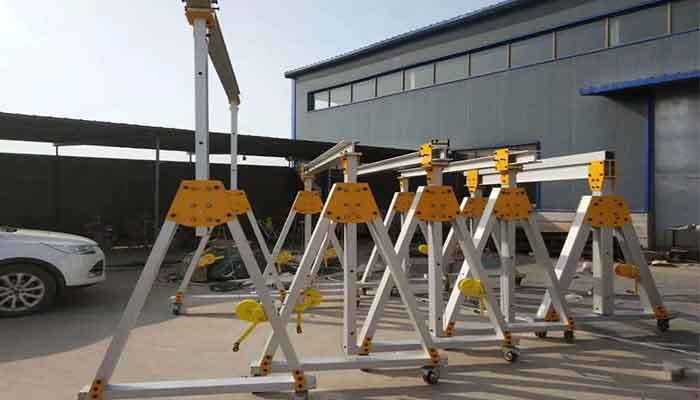
Aluminum A-frame lifting gantries
Comparison:
- Weight and Portability: Aluminum gantries are significantly lighter and more portable than steel gantries, making them suitable for applications where easy transport and setup are critical.
- Strength and Load Capacity: Steel gantries have higher strength and load capacity compared to aluminum gantries, making them ideal for heavy-duty lifting tasks.
- Corrosion Resistance: Aluminum gantries excel in corrosion resistance, making them suitable for outdoor or corrosive environments. Steel gantries may require additional protective measures to prevent corrosion.
- Cost: Steel gantries are generally more cost-effective than aluminum gantries. The cost difference is influenced by the material's availability, manufacturing processes, and specific alloy types.
- Applications: Steel gantries are preferred for heavy-duty industrial applications, while aluminum gantries are well-suited for situations where corrosion resistance, portability, and ease of handling are essential.
In summary, the choice between steel and aluminum A-frame lifting gantries depends on the specific requirements of the application, including load capacity, portability, corrosion resistance, and budget considerations. Steel gantries are robust and durable for heavy-duty tasks, while aluminum gantries offer lightweight and corrosion-resistant solutions for more specialized applications.
Hot Sale of Light Duty A Frame Lifting Gantry Crane for Sale
Customization Options
Customization options for frame lifting gantries cater to specific industry needs and unique lifting challenges. Manufacturers often provide customization in terms of:
- Load Capacity: Tailoring the gantry's load-bearing capacity to meet the demands of specific applications.
- Span Width and Height: Adapting the dimensions of the gantry to accommodate varying load sizes and workspace constraints.
- Specialized Attachments: Adding features like specialized hooks, clamps, or lifting attachments to address unique lifting scenarios.
- Material Selection: Allowing users to choose the material for the gantry structure based on factors such as weight, durability, and environmental considerations.
The different types of A frame lifting gantries and their features enables buyers to select the most suitable configuration for their specific lifting needs. In the next section, we will explore the key features and capabilities that should be considered when evaluating frame lifting gantries for purchase.
Key Features and Capabilities
Load Capacity
- Understanding Load Ratings The load capacity of a frame lifting gantry is a critical factor that directly correlates with its performance. It refers to the maximum weight the gantry can lift safely. When determining the required load capacity, consider not only the weight of the load but also factors like the load's distribution and the angle of the lift. It's essential to choose a gantry with a load capacity that exceeds the heaviest load you anticipate lifting to ensure safety and optimal performance.
- Load Testing and Certification Reputable manufacturers conduct load testing on their gantries to validate their load-bearing capabilities. Buyers should prioritize gantries that come with certifications, indicating that the equipment has undergone rigorous testing and complies with industry standards. This ensures that the gantry is safe and reliable for its intended use.
Span Width and Height
- Adapting to Workspace Constraints The span width and height of a frame lifting gantry determine its ability to accommodate various loads and fit into different workspaces. When selecting a gantry, assess the dimensions of the objects you will be lifting and consider any spatial limitations in your working environment. Choosing a gantry with adjustable span width and height provides added flexibility for diverse lifting scenarios.
- Precision in Positioning For applications that require precise positioning of loads, selecting a gantry with the appropriate span width and height is crucial. An accurately sized gantry minimizes the risk of collisions and ensures efficient and safe lifting operations.
Mobility and Portability
- Considerations for Mobile Gantries For applications that involve lifting in multiple locations, the mobility and portability of a gantry become paramount. Mobile gantries equipped with wheels or casters allow for easy relocation. Buyers should assess the terrain of their workspace and choose a gantry with wheels suitable for the environment, such as non-marking wheels for indoor use or pneumatic wheels for outdoor use.
- Compact Design and Storage Portable gantries often feature a compact design that facilitates storage when not in use. Consider the gantry's dimensions when collapsed or disassembled to ensure it can be conveniently stored in your facility.
Safety Features
- Overload Protection : Load Monitoring Systems Overload protection is a critical safety feature that prevents the gantry from lifting loads beyond its rated capacity. Many modern gantries are equipped with load monitoring systems that provide real-time feedback on the load being lifte These systems can trigger alarms or automatically stop the lifting process if an overload is detecte
- Emergency Stop Mechanisms : Quick Response in Emergency Situations Emergency stop mechanisms are designed to halt the gantry's operation immediately in case of unforeseen circumstances or emergencies. Users can activate these mechanisms through easily accessible controls, ensuring a swift response to mitigate potential risks.
- Stability Enhancements : Outrigger Systems Stability is paramount during lifting operations. Some gantries come with outrigger systems that provide additional support, especially when dealing with uneven surfaces. Outriggers enhance the gantry's stability by distributing the load over a wider area and preventing tipping.
- Leveling Mechanisms : Gantries equipped with leveling mechanisms are crucial for maintaining stability on uneven surfaces. These mechanisms automatically adjust the gantry's legs to ensure a level and secure lifting operation.
Prioritizing these key features and safety capabilities are essential when evaluating frame lifting gantries. In the following section, we will delve into the process of choosing the right frame lifting gantry, considering specific requirements and industry standards.
Heavy Duty A Frame Lifting Gantries vs Light Duty A Frame Lifting Gantries
Similarities:
Both heavy-duty A-frame lifting gantry cranes and light-duty A-frame lifting gantry cranes share common features and functions that contribute to their role in material handling operations.
- A-frame Structure: Both types of gantry cranes are designed with an A-shaped frame, providing stability and support for the lifting mechanism.
- Lifting Mechanism: They utilize a hoist or lifting mechanism to raise and lower loads, ensuring precise control during material handling.
- Mobility: A key similarity is their mobility, allowing them to be moved to different locations within a facility or job site. This enhances flexibility in adapting to changing operational needs.
- Efficiency Improvement: Whether heavy-duty or light-duty, A-frame gantry cranes contribute to increased efficiency in lifting and moving materials, reducing manual labor and potential safety risks.
Differences:
While these gantry cranes share common characteristics, their differences become apparent in terms of load capacity, application, construction, size, cost, and safety features.
Load Capacity:
Heavy Duty: Designed for handling heavier loads, suitable for industrial settings and applications involving large and robust materials.
Light Duty: Suited for lighter loads, commonly used in workshops and smaller manufacturing settings with less demanding lifting requirements.
Application:
Heavy Duty: Ideal for heavy machinery, large components, and applications where substantial lifting capacity is essential.
Light Duty: Commonly employed in smaller manufacturing environments, workshops, or areas where the lifting demands are not as intensive.
Construction Material:
Heavy Duty: Constructed with stronger materials and components to withstand higher loads and more intense usage.
Light Duty: Built with materials appropriate for moderate loads and less frequent use, emphasizing portability.
Size and Portability:
Heavy Duty: Larger and less portable due to the need for robust structural components.
Light Duty: More compact and portable, facilitating easy movement within confined spaces.
Cost:
Heavy Duty: Generally comes with a higher cost due to the use of stronger materials and advanced features.
Light Duty: Offers a cost-effective solution for applications with lower load requirements and less demanding conditions.
Safety Features and Controls:
Heavy Duty: Equipped with advanced safety features and control systems to ensure secure handling of heavy loads.
Light Duty: Typically has basic safety features suitable for its lighter load capacities and less intense applications.
In summary, while both heavy-duty and light-duty A-frame gantry cranes serve the purpose of material handling, their design and specifications are tailored to meet the specific demands of different industries and applications.
Choosing the Right Frame Lifting Gantry
Assessing Specific Lifting Needs
- Understanding Load Characteristics Before selecting a frame lifting gantry, a thorough assessment of specific lifting needs is crucial. Consider the types and characteristics of the loads you will be handling, including weight, dimensions, and center of gravity. Additionally, evaluate the frequency of lifts and the required precision in positioning. This assessment will guide the selection process, ensuring that the chosen gantry aligns with the unique requirements of your application.
- Future-Proofing Anticipate potential changes in your lifting needs over time. Choosing a gantry with flexibility and adaptability allows for future modifications or additions, saving costs in the long run.
Environmental Considerations
- Indoor vs. Outdoor Use Consider the environmental conditions in which the gantry will operate. If your application involves indoor lifting, factors such as floor surface, available space, and ceiling height are critical. For outdoor use, assess the gantry's resistance to weather elements and choose materials that provide corrosion resistance.
- Temperature and Humidity In certain industries, such as manufacturing or aerospace, temperature and humidity levels may vary. Ensure that the chosen gantry is designed to withstand these variations without compromising performance.
Budgetary Constraints
- Total Cost of Ownership While budget constraints are a consideration, it's essential to evaluate the total cost of ownership. Cheaper gantries may initially save costs but may lack durability and features, leading to higher maintenance expenses or early replacements. A well-made gantry with the right features can offer better long-term value.
- Return on Investment Consider the return on investment (ROI) in terms of increased efficiency, reduced downtime, and enhanced safety. A higher upfront investment in a quality gantry can pay off in improved productivity and reduced operational risks.
Compliance with Industry Standards
- Regulatory Requirements Ensure that the selected frame lifting gantry complies with relevant industry standards and regulations. This may include safety standards, load testing requirements, and certifications. Choosing a gantry that meets or exceeds these standards is crucial for creating a safe working environment and avoiding potential legal and safety issues.
- Manufacturer Reputation Select a gantry from reputable manufacturers with a track record of producing reliable and compliant lifting equipment. Research the manufacturer's certifications, reviews, and customer feedback to assess their commitment to quality and safety.
In the subsequent sections, we will explore the installation and maintenance processes of frame lifting gantries, providing insights into assembling and ensuring the long-term reliability of the equipment. Understanding the nuances of these considerations will empower buyers to make informed decisions and select the right frame lifting gantry for their specific needs.
Installation and Maintenance of Frame Lifting Gantries
Assembly Process
- Comprehensive Assembly Instructions The assembly process of a frame lifting gantry is a critical step that directly impacts its performance and safety. Manufacturers provide comprehensive assembly instructions that should be followed meticulously. Ensure that all components are properly aligned, bolts are securely tightened, and safety features are functioning as intended during the assembly.
- Professional Installation Services For complex or large gantries, considering professional installation services may be prudent. Experienced technicians can ensure that the gantry is assembled correctly, reducing the risk of operational issues and enhancing overall safety.
Safety Protocols During Installation
- Risk Assessment Before installation, conduct a thorough risk assessment of the workspace. Identify potential hazards such as uneven surfaces, overhead obstructions, or proximity to other equipment. Implement safety measures, such as barricades and warning signs, to mitigate risks during the installation process.
- Personal Protective Equipment (PPE) Ensure that installation personnel are equipped with appropriate personal protective equipment, including helmets, gloves, and safety footwear. Safety harnesses may be necessary when working at elevated heights.
- Team Training Training installation personnel on safety protocols specific to the gantry and its components is crucial. Emphasize the importance of teamwork, effective communication, and adherence to safety guidelines throughout the installation process.
Routine Maintenance Practices
- Regular Inspections Routine inspections are vital for ensuring the ongoing functionality of a frame lifting gantry. Establish a regular inspection schedule to check for wear and tear, loose bolts, and any signs of damage. Inspect critical components such as the lifting mechanism, structural elements, and safety features.
- Lubrication Proper lubrication of moving parts is essential for preventing friction and ensuring smooth operation. Follow the manufacturer's guidelines regarding the type and frequency of lubrication. Regularly inspect and replace worn-out or contaminated lubricants.
- Electrical System Checks If the gantry features an electric lifting mechanism, conduct regular checks on the electrical system. Verify the condition of cables, connections, and controls. Ensure that emergency stop buttons and overload protection systems are in optimal working order.
Troubleshooting Common Issues
- Establishing a Troubleshooting Protocol Develop a troubleshooting protocol to address common issues promptly. This may include irregularities in lifting operations, unusual sounds, or stability concerns. The protocol should outline step-by-step procedures for identifying, diagnosing, and resolving problems.
- Manufacturer Support and Resources Leverage the manufacturer's support and resources for troubleshooting. Manufacturers often provide technical support, documentation, and access to service personnel who can assist in resolving complex issues.
- Record Keeping Maintain detailed records of maintenance activities, inspections, and any issues addresse This documentation serves as a valuable reference for identifying patterns, tracking the gantry's performance over time, and demonstrating compliance with maintenance protocols.
Adhering to proper installation and maintenance practices is imperative for ensuring the longevity, safety, and optimal performance of a frame lifting gantry. In the upcoming sections, we will explore real-world applications through case studies and delve into advancements in frame lifting gantry technology, providing users with a comprehensive understanding of the evolving landscape in the industry.
Case Studies and Real-World Applications
Construction Industry
Scenario: High-rise Building Construction
- Challenge: Lifting and positioning heavy steel beams and construction materials at various heights in a dynamic construction environment.
- Solution: Mobile frame lifting gantries with adjustable height capabilities are employe The mobility allows for easy repositioning across the construction site, while adjustable height features accommodate different floor levels. Safety features such as overload protection ensure secure lifting operations, enhancing efficiency and reducing downtime.
Manufacturing and Warehousing
Scenario: Heavy Machinery Assembly Line
- Challenge: Lifting and maneuvering large machinery components in a manufacturing facility with limited space.
- Solution: Double leg gantries with compact designs are utilize These gantries provide stability for lifting substantial loads while navigating efficiently through confined spaces. Customization options such as specialized attachments enhance the gantry's adaptability to various assembly tasks, optimizing the manufacturing process.
Shipbuilding and Maintenance
Scenario: Shipyard Operations
- Challenge: Lifting and placing massive ship components during construction and maintenance projects.
- Solution: Fixed frame lifting gantries with high load capacities are deploye The stability of fixed gantries ensures precise positioning of ship components, crucial for the intricate assembly process. Safety features like stability enhancements and emergency stop mechanisms play a vital role in the challenging maritime environment.
Aerospace and Aviation
Scenario: Aircraft Maintenance Hangar
- Challenge: Lifting and positioning aircraft engines and components for maintenance and repairs.
- Solution: Adjustable height gantries with customization options are employe The ability to adjust the gantry's height accommodates the varied dimensions of aircraft components. Customized lifting attachments designed for specific aircraft parts enhance the gantry's efficiency in the highly specialized aerospace environment.
These case studies exemplify the diverse applications of frame lifting gantries across industries, showcasing their adaptability and efficiency in addressing unique challenges. As we delve into the next section, we will explore the technological advancements in frame lifting gantries, uncovering how innovations such as IoT integration and automation are shaping the future of lifting equipment.
Advancements in Frame Lifting Gantry Technology
Integration of IoT and Automation
- Smart Gantries Modern frame lifting gantries are embracing the Internet of Things (IoT) and automation to enhance efficiency and user experience. Smart gantries equipped with sensors and connectivity features allow real-time monitoring of crucial parameters such as load status, temperature, and operational conditions. Automation features enable gantries to perform predefined tasks with minimal manual intervention, optimizing workflow and reducing the risk of human error.
- Predictive Maintenance IoT integration enables predictive maintenance capabilities, where the gantry can predict potential issues based on data analysis. This proactive approach helps in scheduling maintenance activities before critical components fail, minimizing downtime and extending the equipment's lifespan.
Remote Monitoring and Control
- Cloud-Based Platforms Frame lifting gantries are increasingly incorporating remote monitoring and control functionalities. Cloud-based platforms allow users to monitor the gantry's status, performance, and operational data from anywhere with an internet connection. This remote accessibility enhances real-time decision-making, facilitates troubleshooting, and enables timely adjustments to optimize lifting operations.
- Wireless Connectivity Gantries equipped with wireless communication systems enable remote control, allowing operators to adjust settings, initiate emergency stops, or monitor multiple gantries simultaneously. This wireless connectivity enhances flexibility in operation and contributes to a safer working environment.
Energy-Efficient Designs
- Regenerative Systems Energy efficiency is a key focus in modern gantry design. Some gantries incorporate regenerative systems that harness and reuse energy during the lowering phase of the lifting process. This not only reduces energy consumption but also contributes to a more sustainable and cost-effective operation.
- Variable Frequency Drives Gantries equipped with variable frequency drives (VFDs) enable precise control over the motor's speed and power consumption. By adjusting the power output to match the load requirements, VFDs contribute to energy savings and extend the lifespan of electrical components.
Sustainable Manufacturing Practices
- Environmentally Friendly Materials Manufacturers are adopting sustainable practices in the production of frame lifting gantries. The use of environmentally friendly materials, such as recyclable steel and composite materials, reduces the ecological footprint of gantry manufacturing.
- Efficient Manufacturing Processes Efficiency in manufacturing processes contributes to sustainability. Advanced fabrication methods, such as precision laser cutting and robotic welding, minimize material waste and energy consumption during gantry production. Sustainable manufacturing practices align with the growing global emphasis on environmental responsibility.
As frame lifting gantries continue to evolve with cutting-edge technologies, these advancements not only improve operational efficiency but also align with the growing demand for sustainable and environmentally conscious practices in the industrial sector. In the concluding section, we will gather insights from industry experts, share success stories from gantry users, and provide final recommendations for buyers and users looking to invest in this advanced lifting equipment.
User Testimonials and Reviews
Insights from Industry Experts
- Expert Endorsements Industry experts play a pivotal role in validating the effectiveness and reliability of frame lifting gantries. Their insights provide a valuable perspective on the practical applications, benefits, and considerations associated with different gantry models. Look for endorsements and recommendations from experts in the field, as their experience and expertise can guide prospective buyers towards making informed decisions.
- Innovative Use Cases Experts often share innovative use cases and best practices for optimizing gantry performance. Their insights may include recommendations for specific industries, lifting scenarios, or combinations of gantry features that prove particularly effective in addressing unique challenges.
Success Stories from Gantry Users
- Increased Efficiency and Productivity User testimonials from companies that have successfully integrated frame lifting gantries into their operations can shed light on the tangible benefits experience Look for success stories that highlight improvements in efficiency, increased productivity, and reduced operational downtime.
- Cost Savings and ROI Gantry users often share stories about how the initial investment in quality lifting equipment translated into significant long-term cost savings. Understanding the return on investment (ROI) achieved by other users in similar industries provides valuable insights into the financial benefits of choosing the right gantry.
Challenges and Lessons Learned
- Overcoming Operational Challenges Real-world experiences often come with challenges, and user testimonials may highlight the obstacles faced during the implementation of frame lifting gantries. Insights into how these challenges were overcome, the lessons learned, and the adjustments made in response to unexpected situations provide valuable guidance for future users.
- Maintenance and Durability Considerations Understanding the maintenance practices and durability of frame lifting gantries over time is crucial. Users sharing their experiences with routine maintenance, unexpected repairs, and the overall lifespan of the equipment offer practical insights into the long-term reliability of different gantry models.
Incorporating user testimonials and reviews into the decision-making process provides a holistic understanding of the performance, challenges, and overall satisfaction of those who have integrated frame lifting gantries into their operations. In the final section, we will summarize key takeaways from this comprehensive guide and provide recommendations for buyers and users to navigate the landscape of frame lifting gantries successfully.
Custom A Frame Lifting Gantryies for Your Needs.
Key Features:
- Frame Lifting Gantries: Frame lifting gantries are specialized equipment designed for lifting and transporting heavy loads. The A-frame configuration, structural components, and lifting mechanisms are fundamental elements of these gantries.
- Types and Features: Mobile vs. fixed gantries, single vs. double leg gantries, and adjustable height options cater to diverse lifting needs. Key features such as load capacity, span width and height, mobility, and safety mechanisms play a crucial role in gantry selection.
- Choosing the Right Gantry: Assess specific lifting needs, consider environmental factors, account for budgetary constraints, and ensure compliance with industry standards.
- Installation and Maintenance: Proper assembly, adherence to safety protocols during installation, routine maintenance practices, and troubleshooting are vital for gantry performance and longevity.
Final Recommendations for Buyers and Users
- Prioritize Safety: Choose gantries with robust safety features, including overload protection, emergency stop mechanisms, and stability enhancements.
- Align with Specific Needs: Assess and understand your specific lifting requirements before selecting a gantry, considering load characteristics, workspace constraints, and environmental factors.
- Invest in Quality: Consider the total cost of ownership and prioritize gantries from reputable manufacturers, emphasizing durability, reliability, and compliance with industry standards.
- Embrace Technology: Explore gantries with advanced features such as IoT integration, remote monitoring, and energy-efficient designs to enhance operational efficiency.
Future Trends in Frame Lifting Gantry Technology
- Continued IoT Integration: Further integration of IoT technologies for real-time monitoring, predictive maintenance, and data-driven insights.
- Advancements in Automation: Increasing automation capabilities for gantries, enabling more sophisticated and autonomous lifting operations.
- Sustainable Innovations: Ongoing focus on sustainable manufacturing practices and the use of eco-friendly materials in gantry construction.
- Enhanced Safety Features: Continuous improvement of safety features, including more advanced emergency stop mechanisms and adaptive stability controls.
In conclusion, the world of frame lifting gantries is evolving with technological advancements, industry expertise, and user experiences shaping the landscape. By staying informed about the latest trends, prioritizing safety, and aligning with specific operational needs, buyers and users can navigate this dynamic environment effectively. The adoption of frame lifting gantries promises not only increased efficiency in lifting operations but also a future where these devices play a pivotal role in shaping a safer, smarter, and more sustainable industrial landscape.
Main Projects
Related Products

Supplied three grab bucket crane kits to Indonesia, enhancing garbage handling efficiency with high load capacity and reliable performance.
Free consultation to Confirm Parameters & Specifications and Get
Latest Crane Price & Crane Rate.
- Types of overhead cranes : _______?
- Optional: Overhead travelling crane, goliath gantry crane,Slewing jib crane, Single girder or double girder crane,small portable crane or kbk crane, etc.
- Capacity of overhead crane: _______?
- Optional: 0.25ton, 0.5 ton, 1 ton, 2 ton, 3ton, 5 ton, 10 ton,15ton, 20ton, 25 ton, 30ton,35ton, up to 550ton, etc.
- Crane span & lifting height : _______?
- Crane travelling length : _____?
- Control of overhead crane:_______?
- Optional: pendant/ remote/cabin control
- Voltage supply of overhead crane:_____?
- Eg,: 380V50/60HZ,3Phase or others,etc.
- Application/usage of crane:_______?
- Eg,: Steel mill, ,injection mold, cement,stone, concrete,granite, general manufacturing, etc.
Just leave a message via the contact form and our hoist and crane engineer will contact you with in 24working hours.
Get In Touch
